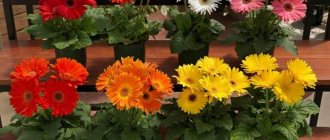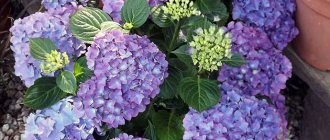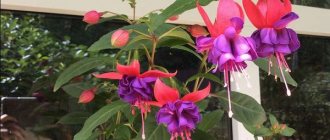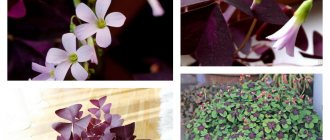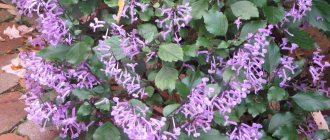Description of indoor gerbera
The plant reaches 25-55 cm in height. In this case, maximum growth is possible during the flowering period due to the formation of a peduncle from a leaf rosette. At its top a basket blooms no more than 14 cm in diameter. During flowering, the petals can be of any color. There are types with pink, white, burgundy and other shades.
The leaves are arranged in several tiers on small petioles. They have a pinnately dissected shape, the central part is more elongated. The leaf color is dark green. Sometimes there is thick soft pile on the petioles.
Temperature
In summer, the optimal temperature for gerbera will be 20-25 degrees. In autumn – 18-20 degrees, in winter – 14-16 degrees. A decrease in temperature in the autumn-winter period is necessary to ensure a dormant period. If you follow this regime, already at the end of February the plant will again delight you with bright flowering.
If the temperature is not lowered in winter, the gerbera will bloom in winter.
But, if you do not understand the temperature in winter, the gerbera will quickly become depleted and will have to be replaced with a new specimen.
Although the Transvaal chamomile loves fresh air, it is better to protect it from drafts and cold winds. It is important to avoid sudden temperature changes.
Gerbera classification
Two types of plants are popular - jamesona and green-leaved. Basically all the indoor ones were bred from the first grade.
| Type, petals | Inflorescences | Variety, flowers |
| Small-flowered, narrow | Small flowers up to 9 cm in diameter. | Aldebaran is pink. Alkar is a shade of ripe cherry. |
| Large-flowered, narrow | Reach 13 cm. | Vega - orange. Jupiter - bright yellow. Algol – ripe cherry. |
| Large-flowered, medium | Medium diameter. | Mars is red. |
| Large-flowered, wide | Large up to 15 cm. | Delios, Markal - sunny color. |
| Terry, narrow | Medium size up to 11 cm. | Kalinka - yellow shades. Viola – rich pink. Sonya - red tones. |
| Terry, wide | Large ones. | Spark - bright, deep red |
Beneficial features
Gerbera is valued primarily for its decorative properties. When cut in a vase in fresh water with the addition of aspirin, the flowers can retain their attractive appearance for 20 days. The smell of the plant is very faint, so it cannot harm people prone to allergic reactions. The house in which the gerbera grows impresses with a combination of comfort and respectability.
Dwarf varieties grown at home purify the air well, increasing the oxygen content.
Bright yellow and orange gerbera inflorescences can compensate for the lack of sun in cloudy weather.
Care for gerbera at home
The plant, which is native to South Africa, requires conditions approximately similar to its natural habitat. By following the rules, you can increase the duration of flowering.
| Factor | Spring Summer | Winter | Autumn |
| Location | Place it on the window sill on the east or west side. The room must be ventilated every day. In summer they are moved outside or transplanted into open ground. | ||
| Lighting | Place in a shaded place. | Fluorescent or phytolamps are used to provide the plant with light. | |
| Temperature | Does not tolerate heat above +30…+32 °C. The leaves are withering. | At +12…+14 °C the flower goes into hibernation, flowering is impossible during this period. However, temperatures lower than this may kill the plant. | The normal temperature is +20…+24 °C. |
| Humidity | Requires a humidity of 70-80%, so in the summer the area around it is sprayed. | ||
| Watering | Moderate, as the right layer of soil dries out. Water at room temperature (+20…+22 °C). If necessary (in summer, when placed near a battery), spray the space near the plant or place a humidifier nearby. | ||
| Top dressing | Nitrogen fertilizer is suitable in February, July-August, and during flowering - potassium fertilizer. The solution is first diluted with water, and the soil is watered in a small amount. | ||
Planting, replanting, soil for gerberas
Replanting a plant begins with choosing a pot. It should be clay, this allows the gerbera roots to breathe and maintain the required soil temperature.
You can replant two weeks after purchasing the flower. This allows the plant to get used to new conditions.
Experienced gardeners also recommend:
- choose a pot twice the size of the old one;
- treat the container with boiling water;
- replace all the soil and shake off the roots;
- if the plant is young, then fertilize every 5-7 days.
Jemson
For planting, light, slightly acidic soil is used. You can make it yourself (2:1:1):
- deciduous soil;
- peat;
- sand.
Expanded clay or pine bark as filler.
Replant during dormancy, when gerbera does not bloom. In this case, the root rosette is left to protrude from the ground by 1-2 cm.
Features of care in a new place
In order for African chamomile to take root faster, it is provided with favorable conditions. These conditions include:
- temperature regime – 21-24 degrees,
- light mode – about 10-12 hours,
- regular and moderate watering – once every 10-14 days,
- feeding - no earlier than after 25 days.
Gerbera is quite easy to care for. It is very important to follow simple care rules after purchasing and replanting a plant. And by providing proper care, it will thank its owners with long-lasting and vibrant flowering.
Gerbera propagation
Experts identify two methods for propagating indoor flowers using seeds or dividing the bush.
Using seeds
Suitable for gardeners who want to grow a new variety or propagate gerbera. Seeds are purchased at the store or collected during flowering. For reproduction you will need:
- pour 1-2 cm of soil (a mixture of turf and sand) into the pot;
- lay out the seeds and sprinkle them with soil, but no more than 5 cm;
- cover with film and moisten the soil with a sprayer;
- leave in a warm, bright place;
- Constantly ventilate and moisten until the first leaves;
- After 3-4 leaves appear, divide into small pots.
Dividing the bush
The method is suitable if there is a plant older than two years, it can then be replanted. After dividing, the gerbera is watered and taken to a place where there is no direct sunlight, maintaining a moderate temperature.
Step by step:
- remove the plant from the pot and shake off the roots from the ground;
- divide into 3-4 bushes, leaving two points for growth;
- trim the roots by 10 cm;
- plant the plants in pots and sprinkle with soil;
- rosettes should be 1 cm above the soil.
Green leaf
Lighting
Gerbera loves bright but diffused light. This determines whether it will bloom and, if so, for how long.
The optimal place for it would be windows facing west and east. The exposure to morning and evening sunlight will come in handy.
In the warm season, gerberas can be moved to a balcony or garden - fresh air will be beneficial.
To achieve repeated flowering of gerbera in autumn and winter, it must be illuminated with a fluorescent lamp. It should be placed above the plant at a height of 70-80 cm. Illumination time is 12-14 hours a day.
Errors in care, diseases and pests
Gardeners often make mistakes in caring for gerbera, which leads to its condition worsening. However, if you notice this process in time, you can correct the shortcomings and return the plant to its original appearance.
Typical mistakes in care
| Manifestations | Cause | Corrective measures |
| Yellow leaves | Incorrect watering, too abundant or, on the contrary, scanty. | The water should be at room temperature and watering should be moderate. |
| Withering leaves | Lack of water, dry air. | Spray the plant and water more often. |
| Darkening or fading petals | Lack of light. | Move the pot of gerbera to the sunny side. |
| Dried leaves | Incorrectly selected fertilizer or lack of it. | Purchase a nitrogen substrate. |
| Yellow spots on leaves | Sunburn. | Move the plant into the shade, and also spray not the plant itself, but the space around it, so that water does not get on the leaves. |
| Doesn't bloom | Incorrectly selected pot, soil or location. | Transplant the gerbera into a larger container. Move to the side where there is less sun, and also change the soil with less nitrogen. |
| Blackening stem | Low temperature, abundant watering. | Moisten the soil less often. Move to a room where the air will be warmer. |
Fertilizer
From March to November, gerbera needs regular mineral feeding - twice a month.
During the period of budding and growth of green mass - March, April, June-August - it is better to feed the plant with fertilizers with a high nitrogen content. And during flowering - with a high potassium content.
For gerbera, you can use complex fertilizers for flowering plants.
However, the concentration indicated on the packaging must be halved. Gerbera gerberas cannot be fed with organic fertilizers.
Possible growing problems
A beautiful flowering plant can be spoiled by pests and disease. As soon as problems with the health of a gerbera are noticed, you need to immediately begin treating it.
- Powdery mildew appears due to cold watering and sudden changes in ambient temperature, and excess nitrogen can also be the cause.
- White and gray mold are the result of stagnant moisture. It mainly affects the foliage part of the gerbera, but sometimes it spreads to the stems.
- Late blight, like mold , appears due to high and constant soil moisture. Lack of watering can lead to the appearance of spider mites, which suck out the already missing liquid from the plant. Spraying with fungicides helps in the fight against mites.
- Aphids and whiteflies are insects that can most often appear on various plants; you can get rid of them with preparations containing copper.
- If gerbera leaves turn yellow, and then fall off - this is a sign of rotting of the root system due to high humidity. To save the plant, you need to dry the soil and then water more moderately. If this does not solve the problem, the plant needs to be transplanted into new soil, removing the rotten roots.
- A thin or weak peduncle indicates a lack of lighting; the problem is solved by adding light.
- Growing foliage and lack of flowers means that there is too much nitrogen in the fertilizer, which prevents the plant from entering the bud development phase.
- Limp leaves indicate insufficient watering. Gerberas need to be watered every other day, maximum two, paying attention to drying the surface layer of soil.
Gerbera can be considered a domestic sunflower, which is not so difficult to care for if the necessary conditions are created. The bright flowers of the plant will attract even the most indifferent observer.
Quince stuffed with pork and black lentils
Category: Hot dishes Dishes from vegetables, mushrooms, legumes Hot dishes from legumes
The combination of quince with meat is extremely successful - seemingly inconspicuous, hard as a stone, tart to the extreme, quince has such a luxurious aroma and pleasant sourness that its presence can make any dish exquisitely aristocratic. The addition of black lentils gives this dish a special charm, and the delicate creamy pesto sauce brings all the flavors together harmoniously. This dish will look great both during a family dinner and on a holiday table.
Types of tobacco
Rod Tobacco
includes 75 species, which are distributed in 13 sections:
Popular articles Anthurium crystal: care at home
- Nicotiana sect. Alatae Goodsp.
- Nicotiana sect. Nicotiana
- Nicotiana sect. Noctiflorae Goodsp.
- Nicotiana sect. Paniculatae Goodsp.
- Nicotiana sect. Petunioides G.Don
- Nicotiana sect. Polydicliae G.Don
- Nicotiana sect. Repandae Goodsp.
- Nicotiana sect. Rusticae G.Don
- Nicotiana sect. Suaveolentes Goodsp.
- Nicotiana sect. Sylvesters S.Knapp
- Nicotiana sect. Tomentosae Goodsp.
- Nicotiana sect. Trigonophyllae Goodsp.
- Nicotiana sect. Undulatae Goodsp.
| Section | Latin name | Russian name |
| Noctiflorae | Nicotiana acaulis Speg. | |
| Petunioides | Nicotiana acuminata (Graham) Hook. | Tobacco, pointed |
| Suaveolentes | Nicotiana africana Merxm. | |
| Alatae | Nicotiana alata Link & Otto | Winged tobacco, or decorative tobacco |
| Noctiflorae | Nicotiana ameghinoi Speg. | |
| Suaveolentes | Nicotiana amplexicaulis NTBurb. | |
| Undulatae | Nicotiana arentsii Goodsp. | |
| Petunioides | Nicotiana attenuata Torr. ex S.Watson | Tobacco drawn |
| Alatae | Nicotiana azambujae LBSm. & Downs | |
| Paniculatae | Nicotiana benavidesii Goodsp. | |
| Suaveolentes | Nicotiana benthamiana Domin | |
| Alatae | Nicotiana bonariensis Lehm. | |
| Suaveolentes | Nicotiana burbidgeae Symon | |
| Nicotiana ×calyciflora Caille ex Comes | ||
| Suaveolentes | Nicotiana cavicola NTBurb. | |
| Polydicliae | Nicotiana clevelandii A.Gray | Cleveland tobacco |
| Paniculatae | Nicotiana cordifolia Phil. | |
| Petunioides | Nicotiana corymbosa J.Rémy | |
| Paniculatae | Nicotiana cutleri D'Arcy | |
| Suaveolentes | Nicotiana debneyi Domin | |
| Nicotiana ×edwardsonii Christie & DWHall | ||
| Suaveolentes | Nicotiana excelsior (JMBlack) JMBlack | Tobacco increased |
| Nicotiana ×flindersiensis Nicholls | ||
| Alatae | Nicotiana forgetiana hort. ex Hemsl. | Tobacco Forgeta |
| Suaveolentes | Nicotiana fragrans Hook. | |
| Noctiflorae | Nicotiana glauca Graham | Tobacco tree, or Tobacco blue, or Tobacco tree |
| Undulatae | Nicotiana glutinosa L. | Sticky tobacco |
| Suaveolentes | Nicotiana goodspeedii H.-M.Wheeler | |
| Suaveolentes | Nicotiana gossei Domin | |
| Suaveolentes | Nicotiana heterantha Symon & Kenneally | |
| Tomentosae | Nicotiana kawakamii Y.Ohashi | |
| Paniculatae | Nicotiana knightiana Goodsp. | |
| Alatae | Nicotiana langsdorffii Weinm. | Langsdorff tobacco |
| Petunioides | Nicotiana linearis Phil. | |
| Petunioides | Nicotiana longibracteata Phil. | |
| Alatae | Nicotiana longiflora Cav. | Long-flowered tobacco |
| Suaveolentes | Nicotiana maritima H.-M.Wheeler | |
| Suaveolentes | Nicotiana megalosiphon Van Heurck & Müll.Arg. | |
| Petunioides | Nicotiana miersii J.Rémy | |
| Suaveolentes | Nicotiana monoschizocarpa (P.Horton) Symon & Lepschi | |
| Alatae | Nicotiana mutabilis Stehmann & Semir | |
| Noctiflorae | Nicotiana noctiflora Hook. | |
| Repandae | Nicotiana nudicaulis S.Watson | |
| Trigonophyllae | Nicotiana obtusifolia M.Martens & Galeotti | Tobacco blunted |
| Suaveolentes | Nicotiana occidentalis H.-M.Wheeler | |
| Tomentosae | Nicotiana otophora Griseb. | |
| Noctiflorae | Nicotiana paa Mart.Crov. | |
| Paniculatae | Nicotiana paniculata L. | Tobacco paniculata |
| Petunioides | Nicotiana pauciflora J.Rémy | |
| Noctiflorae | Nicotiana petunioides (Griseb.) Millán | |
| Alatae | Nicotiana plumbaginifolia Viv. | Lead-colored tobacco |
| Polydicliae | Nicotiana quadrivalvis Pursh | Four-leaf tobacco, or Indian tobacco |
| Paniculatae | Nicotiana raimondii JFMacbr. | |
| Repandae | Nicotiana repanda Willd. ex Lehm. | Notched tobacco |
| Suaveolentes | Nicotiana rosulata (S.Moore) Domin | |
| Suaveolentes | Nicotiana rotundifolia Lindl. | |
| Rusticae | Nicotiana rustica L. | Makhorka, or country tobacco |
| Alatae | Nicotiana ×sanderae W.Watson | Tobacco Sander, or Garden Tobacco |
| Tomentosae | Nicotiana setchellii Goodsp. | |
| Suaveolentes | Nicotiana simulans NTBurb. | |
| Paniculatae | Nicotiana solanifolia Walp. | |
| Petunioides | Nicotiana spegazzinii Millán | |
| Repandae | Nicotiana stocktonii Brandegee | |
| Suaveolentes | Nicotiana suaveolens Lehm. | Sweet tobacco |
| Sylvesters | Nicotiana sylvestris Speg. & Comes | Wild tobacco |
| Nicotiana | Nicotiana tabacum L.typus | Common tobacco, or Virginia tobacco |
| Undulatae | Nicotiana thyrsiflora Bitter ex Goodsp. | |
| Tomentosae | Nicotiana tomentosa Ruiz & Pav. | Felt tobacco |
| Tomentosae | Nicotiana tomentosiformis Goodsp. | |
| Suaveolentes | Nicotiana truncata Symon | |
| Suaveolentes | Nicotiana umbratica NTBurb. | |
| Undulatae | Nicotiana undulata Ruiz & Pav. | |
| Suaveolentes | Nicotiana velutina H.-M.Wheeler | |
| Undulatae | Nicotiana wigandioides K.Koch & Fintelm. | |
| Suaveolentes | Nicotiana wuttkei JRClarkson & Symon |
